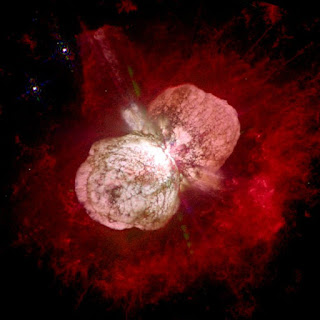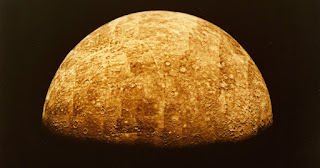Eta Carinae
Eta Carinae (η Carinae) is a stellar system containing at least 2 stars within a nebula. It was formerly known as Eta Argus in the early 19th century. Their combined luminosity (radiated power) is more than 5 million times that of the Sun. The primary star was 250 times the mass of the Sun, but it has lost at least 30 solar masses recently and is expected to explode as a supernova. It is the only star known to produce ultraviolet laser emission. The second star is about 80 times as massive as the Sun. 130 years ago, the primary star exploded, but kept the star intact. The original explosion created a huge 10-solar-mass cloud that expanded at more than 20 million miles per hour – fast enough to travel from Earth to Pluto in a few days. [source: “Astronomers stunned again by Eta Carinae – the star that will not die,” Astronomy Now, Aug 3, 2018]
The stellar system is located in the constellation Carina (between Canopus and the Southern Cross) in the southern sky, 7,500 light-years away.
The Eta Carinae star system is one of the most massive star systems that can be studied in detail. It is expelling a mass equal to the Sun every 3,000 years. Its stellar wind was measured at about 1.5 million miles per hour. The energy it emits, much of it in invisible radiation, is up to 5 times more powerful than the sun.
Eta Carina A is classified as a luminous blue variable (LBV). Eta Carinae B is a massive luminous blue star.
The nebula surrounding Eta Carinae is the Keyhole Nebula, one of the brightest nebulae in the sky,
In the 17th century, Eta Carinae was first recorded as a 4th-magnitude star.
In 1677, Edmond Halley recorded the star, calling it Sequens. He observed the star from St. Helena.
In 1827, astronomer William John Burchell (1781-1863) noted Eta Carinae’s unusual brightness, and was the first to suspect that it varied in brightness.
In 1835, the stellar system brightened to become brighter than Rigel, which has an absolute magnitude of 7.84 and an apparent magnitude of 0.12. It was the brightest star in the southern sky.
In 1837, astronomer John Herschel was in South Africa and noted that the star brightened to to slightly outshine Rigel. This event marked the beginning of a 18-year period known as the Great Eruption.
In March 1843, it became the
second brightest star in the sky (behind Sirius) before fading below naked eye visibility
in 1868. It faded because an immense
cloud of dust from its eruption obscured the view. It became visible again when the dust
cleared.
For a time, Eta Carinae was an important navigation star for mariners in the southern seas.
In 1847, John Hershel charted some 1,200 stars in the nebula surrounding Eta Carinae. The hot glowing clouds around Eta Carinae are known as tge Homunculus Nebula.
In 1881, astronomer John Tebbutt (1834-1916) read a paper on the variable star Eta Carinae at the Royal Society of New South Wales, Australia.
In 1887, a new brightness started, peaking at 6.2 magnitude in 1892.
In 1892, it reached 6th magnitude before fading again.
In 1897, Eta Carinae was considered the most unique of variable stars. From 1843 to 1853, the star was the second brightest in the sky. [source: The Brooklyn Daily Eagle, Jan 27, 1897, p. 17]
In 1979, Eta Carinae blinked into view, dimly at first, after an 80-year absence.
In 1982, Eta Carinae was considered the largest star in the Milky Way, one of the most massive stars in the universe, and about to become a supernova. The last supernova to occur in the Milky Way was observed in 1604. When Eta Carinae explodes, it should appear 5 times brighter than Venus at its brightest. [source: Logansport (Indiana) Pharos-Tribune, April 21, 1982, p. 20]
In 1991, the Hubble wide-field camera was used to take photos of Eta Carinae. It took about two months to process the images.
In 1994, new images taken of Eta Carinae by the repaired Hubble Space Telescope showed that the star had formed two spherical clouds joined in the middle, creating a shape that resembled a barbell. [source: The San Bernardino County Sun, June 1, 1994, p. 8]
In 1996, variations in brightness
of the stellar system were measured and had a period of 5.54 years. This led to the idea that this was a binary
system. In 1996, Brazilian astronomer
Augusto Daminelli proposed that the system was a binary system.
In 1999, Eta Carinae suddenly doubled in brightness. Its energy output tripled in 18 months. [source: The Galveston Daily News, June 3, 1999, p. 3]
In 2005, it was confirmed that this was a binary stellar system. The two starts revolved about each other every 5.5 years on strongly elliptical orbits. The distance between them vary greatly, roughly between the from our sun to Mars, and that from our sun to Uranus. [source: www.dw.com, March 7, 2020]
In 2009, satellites detected high-energy gamma radiation up to 10 GeV from Eta Carinae.
In 2014, it had a magnitude of 4.5.
In July 2018, Eta Carinae was reported to have the strongest colliding wind shock in the solar neighborhood. It was observed by the NuSTAR satellite. The stellar winds meet every 5.5 years. Where they meet, a huge and extremely hot shock front develops with temperatures of around 50 million degrees Celsius.
In 2021, it was proposed that the star system used to be a triple system that eventually became unstable and caused a stellar merger. The 1840s mass ejection was triggered when the primary star devoured one of its companions, rocketing more than 10 times the mass of our sun itno space. [source: SciTechDaily, March 21, 2021 and The Bisouv Network, March 29, 2021]
The star is not visible above latitude 30 degrees North.
The two main stars of the Eta Carinae system have an eccentric orbit with a period of 5.539 years. The period has changed over time due to mass loss and accretion.
The stellar system is generating
gamma radiation with an energy of up to 400 gigaelectron volts (GeV) – about 100
billion times more than the energy of visible light. The star system is the first known example of
a source in which very high energy gamma radiation is generated by colliding
stellar winds.





Comments
Post a Comment